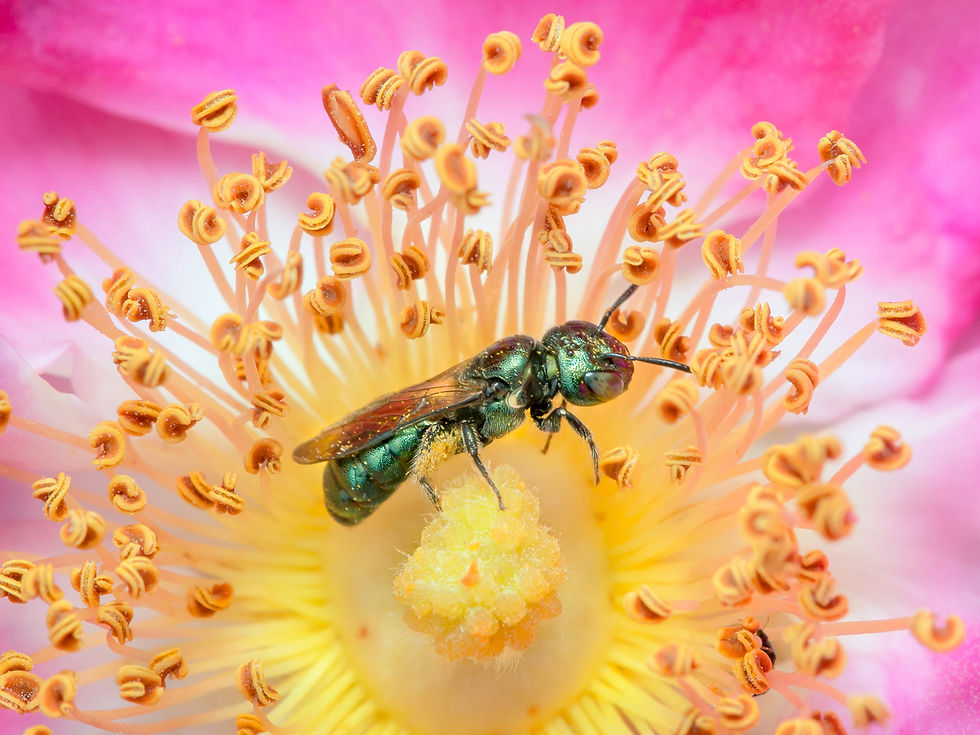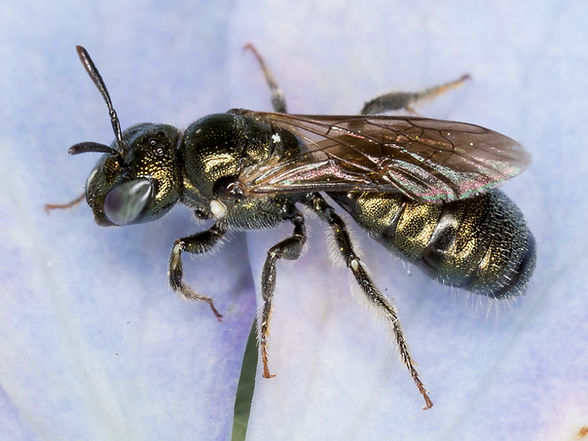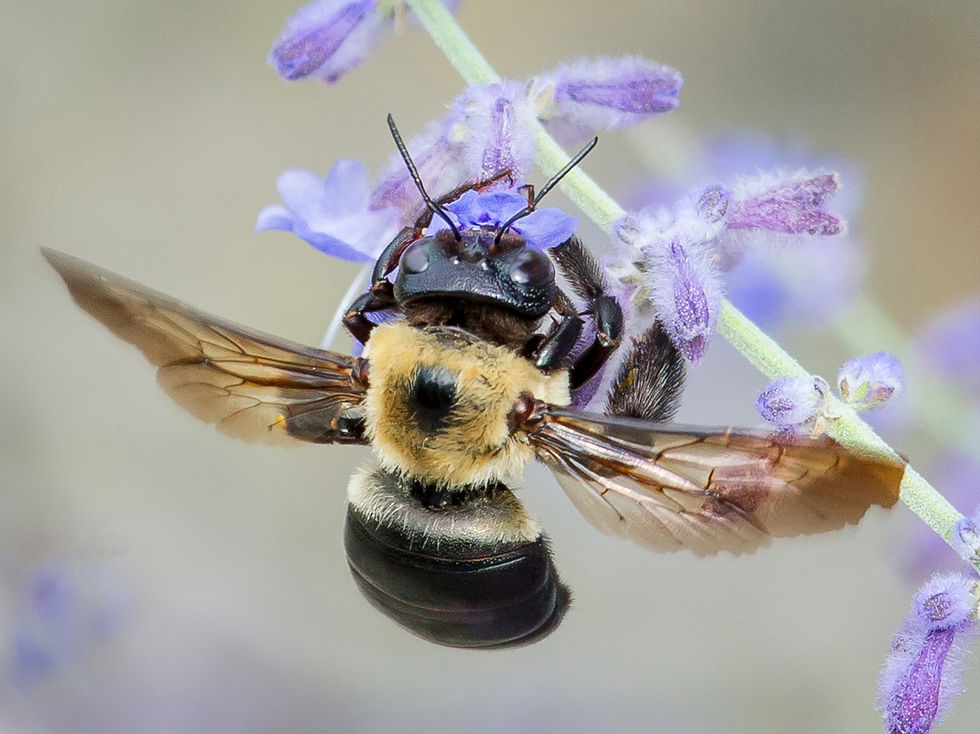SHARP-EATMAN
NATURE
PHOTOGRAPHY
ID GUIDE TO WILD BEES - NEW YORK

SMALL & LARGE CARPENTER BEES
Ceratina & Xylocopa
SMALL CARPENTER BEES: Genus Ceratina
Spurred Small Carpenter Bee
(Ceratina calcarata)
1/5" - 1/3" (small to very small)
Nimble Small Carpenter Bee
(Ceratina strenua)
1/6" - 1/5" (very small)
Small carpenter bees are important generalist pollinators of wildflowers and garden flowers. Because of their size, they are able to enter small-mouthed flowers unreachable by larger bees. These little wild bees are key pollinators of early spring bloomers such as hepatica, claytonia, Solomon's seal and yellow violets. In the summer, small carpenter bees are seemingly ubiquitous, appearing on an impressive variety of wildflowers in the park -- among others, mountain mint, fleabane, milkweed, dogbane, bellflowers, penstamon, thistles, goldenrod, black-eyed Susans and wild roses. Small carpenter bees are widely visible in the flower gardens and fields of Stone Barns from spring through early fall. These bees are significant pollinators of many kinds of fruit and vegetable crops, including apples, peaches, caneberries, blueberries, carrots and melons.
Small carpenter bees construct nests in burrows within dead wood or plant material, creating dividers for egg chambers by scraping fibers from tunnel walls. Small carpenter bees do not bore holes in wooden parts of buildings like eastern large carpenter bees and are not considered pests. Instead, small carpenter bees build solitary nests in the dead stems of pithy plants such as fennel, sunflowers, pokeweed, elderberry and blackberry.
Identifying traits: Small carpenter bees are slender, dark and hairless or sparsely haired. They look a bit like winged ants and bear little resemblance to the large eastern carpenter bees shown above. Small carpenter bees can be shiny black or metallic green or blue and sometimes have pale markings on their heads, bodies or legs. Their faces, thoraxes and abdomens are pitted. Females carry pollen on brushes located on their hind legs. Small carpenter bee abdomens are clublike, belling outward at the tips, a trait that helps distinguish them from other small wild bees.
There are 24 documented species of small carpenter bees in the United States and Canada; foC. strenuaur are found in New York (Ceratina calcarata, C. dupla, and C. mikmaqi). These four are very similar: all are 1/3" in length or smaller, and all are a dark metallic green or blue-green. The first two appear in the park and Stone Barns.
SPURRED SMALL CARPENTER BEE. The spurred small carpenter bee (Ceratina calcarata) is the most common Ceratina species of our area. Ceratina calcarata are usually about 1/5 to 3/10 inches (5 to 8 mm) in length. The female spurred carpenter bee usually has an ivory dot on its face; males have a larger ivory marking shaped like an inverted T. Some females lack facial markings. Spurred small carpenter bees also have an ivory dot on each front tibia, where the femur joins the tibia. These traits are shown in the photo strip at right. The spurred small carpenter bee has been described as "nest loyal" -- that is, females cohabit nests with their offspring, caring for them egg through adulthood.
NIMBLE SMALL CARPENTER BEE. The nimble small carpenter bee (Ceratina strenua) looks nearly identical to the spurred carpenter bee, when viewed with the naked eye. Nimble carpenter bees are generally smaller, running from just under to just over 1/5 inch (4.5 to 5.5 mm) in length. Other differences are perceptible only under strong magnification. The distinguishing trait of the female nimble carpenter bee is an ivory stripe running one third to two thirds the length of the tibia. Just above this is a small ivory mark on the end of the femur that touches the tibia. The female nimble small carpenter bee also has an oblong ivory spot on its face. The male nimble small carpenter bee is distinguished by an even subtler trait -- the shape of a minute projection on the tip of its abdomen.
Taxonomy: Small and large carpenter bees belong to the same subfamily Xylocopinae of the bee family Apidae. The subfamily Xylocopinae is represented by two distinct genera (genuses) in the United States: Xylocopa (large carpenter bees) and Ceratina (small carpenter bees).
Given that they look so different, why do small and large carpenter bees share the same name? Small and large carpenter bees both possess two qualities common to their subfamily. According to Charles D. Michener, author of the encyclopedic The Bees of the World, Xylocopinae store food for adult bees, rather than for young only, a practice unusual in the bee world. Small and large carpenter bees also share a distinctive physical characteristic: both have relatively flat faces.
TAXONOMY - Spurred Small Carpenter Bee
Order: Hymenoptera
Family: Apidae
Subfamily: Xylocopinae
Genus: Ceratina
Subgenus: Zadontomerus
Species: Ceratina calcarata, Ceratina strenua

A female spurred small carpenter bee on a wild rose
All photos (c) 2014 - 2017 Sharp-Eatman Nature Photography

A female spurred small carpenter bee on a wild rose

Female spurred small carpenter bees are metallic blue-green. They have pale hairs on their hind legs and white hairs lining the lower edges of their abdomens.

Close-up of the abdomen of a female spurred small carpenter bee: the abdomens of small carpenter bees are clublike, belling outward at the tip.

A female nimble small carpenter bee
LARGE CARPENTER BEES: Genus Xylocopa
SMALL CARPENTER BEES: Genus Ceratina
Eastern Carpenter Bee
(Xylocopa virginica)
1/2" - 1 1/4" (large)
Like bumble bees, large carpenter bees practice buzz pollination -- that is, they vibrate flight muscles in order to shake pollen from flowers. This makes them key pollinators of tomatoes, eggplants and peppers, which require buzz pollination. The bees' considerable size and attendant ability to carry prodigious pollen loads make them highly effective crop pollinators.
Eastern carpenter bees are also excellent generalist pollinators. During the summer, eastern carpenter bees can be spied most often visiting the blossoms of wild blackberries growing in the park and foraging amid tobacco plants and red bee balm at Stone Barns. The bees are important pollinators of a variety of other native flowers as well, including thistles, mountain mint, goldenrod and coneflowers, all of which they frequent at both locations.
You may have noticed these bees hovering near rotting wooden structures. Male eastern carpenter bees have a characteristic way of flying: they sometimes circle quickly and then hang suspended in front of you, buzzing loudly in mid-air. Don't be alarmed: male carpenter bees may fly aggressively, but do not have stingers and do not sting or bite. Females have stingers but are nonaggressive.
Wild bees have various methods of constructing nests -- many native bees nest within holes in the ground. Carpenter bees are tunnel nesters -- this means that they build tubular nests within wood or plant material. Females scrape wood fibers from the walls of their tunnels to form a kind of particle board used to divide their nests into separate egg chambers. These bees nonetheless do not eat wood; they feed exclusively on pollen and nectar.
The social structure of eastern carpenter bee groups is somewhat unusual. The bees’ colonies lack a queen. Instead, groups of dominant older females construct nests, gather pollen and produce eggs. Younger females guard nest entrances. Males hover nearby the nests, protecting them from intruders.
dentification Information: As shown in the photos here, the eastern carpenter bee has a bulky black body and a golden-haired thorax with a black spot in the middle. The female eastern carpenter bee's abdomen looks like patent leather - it is black and shiny. Female bees of the subspecies found at Stone Barns Center for Food and Agriculture (Xylocopa virginica virginica) have black eyes and sculpted black helmet-like heads that appear flat in front. Male carpenter bees of the same subspecies look significantly different from the females: their bodies are heftier; they usually have white or yellow markings on their faces; their eyes are greenish and protuberant; and their heads lack the sculpted helmet-like shape characteristic of the female bees.
Eastern carpenter bees are sometimes confused with bumble bees. The latter, however, can be distinguished because their abdomens are furry-looking, rather than smooth and shiny like those of carpenter bees. Eastern carpenter bees also bear a superficial resemblance to the giant resin bee (shown in the photo strip here), an invasive species that likes to nest in abandoned carpenter bee nests. (Information on that bee is provided on the leafcutter page of this guide.)
Eastern Carpenter Bees and "Nectar-Robbing":
In most bee species, females rather than males gather pollen, thus enabling flower pollination. Male bees do not collect pollen: instead, they survive by drinking nectar from blossoms. Females also may drink nectar (in addition to gathering pollen).
Eastern carpenter bees, in their quest for nectar, sometimes engage in a form of foraging known as "nectar robbing". What exactly is nectar-robbing? Carpenter bees' large size prevents them from entering tubular flowers to drink their nectar. When encountering deep, narrow-throated flowers such as blueberry blossoms, the bees use their bladed mouth-parts to slice holes in the bases of the blossoms. The bees then lap up the nectar without touching the pollen-carrying parts of the flower. Other pollinators thereafter may shun the depleted flowers, arousing fears that such carpenter bee visits curtail pollination.
Recent studies of blueberry pollination, however, have suggested that carpenter bee nectar-robbing is not necessarily detrimental and may at times play a part in enhancing pollination. A 2004 study of blueberry pollination conducted by entomologists Sampson, Danka and Stringer found that honey bees visited blueberry blossoms by taking advantage of entrances slit open by male eastern carpenter bees. The carpenter bees' presence thus increased honey bee pollen-gathering on blueberry flowers (as well as secondary honey bee nectar-thieving). The study concluded that nectar-robbing male eastern carpenter bees were benign or even potentially beneficial floral visitors of blueberries.
Other studies have shown that nectar-robbing may have a more far-reaching beneficial effect on pollinator habitats. Bees sometimes curtail the time they spend on flora depleted by nectar- robbing. Instead, they make several short visits to many flowers (rather than lingering on a few flowers that are well-endowed with nectar). As a consequence, pollen picked up by the bees is disseminated over a broader group of flowers within a given plant species. This increases the genetic pool that contributes to seed formation, resulting in a richer, more genetically diverse plant population, which better ensures species survival.
Related species: There are two species of large carpenter bees in the eastern United States. The second variety, known as the southern carpenter bee (Xylocopa micans), does not extend as far north as New York. Southern carpenter bees are solitary and do not cause destruction to manmade wooden structures; instead these bees nest in woody plant material.
The southern carpenter bee differs in appearance from the eastern carpenter bee. The female southern carpenter bee, shown in the photo strip here, lacks the helmet-like head of the eastern carpenter bee; has an iridescent greenish-blue body; and has pale hairs on the first segments of its sternum (underside) and on the tip of its abdomen. The male southern carpenter bee has a collar of of golden reddish hair on its thorax as well as protuberant green eyes.
TAXONOMY - Eastern Carpenter Bee
Order: Hymenoptera
Family: Apidae
Subfamily: Xylocopinae
Genus: Xylocopa
Species: Xylocopa virginica

A female eastern carpenter bee (Xylocopa virginica virginica)

A male eastern carpenter bee (Xylocopa virginica virginica)

A female carpenter bee of the subspecies xylocopa virginica virginica: note the pitted, helmet-like head.

A female carpenter bee: note the shiny, patent-leather like abdomen.

A female carpenter bee, whowing the characteristic golden-haired thorax with the dark spot at its center
ABOUT CARPENTER BEE WOOD DAMAGE:
Despite the limited harm carpenter bees sometimes inflict on man-made wooden structures, they merit protection because their benefit to commercial crops and the environment far outweighs their potential for destruction.
Fears of eastern carpenter bee damage to buildings are somewhat overblown, because the bees are small and they appear in small groups, not large colonies; and because they lack the ability to bore holes in wood unless the wood is already rotting. (Their arrival may be a sign that wood structures need replacement. )
Most notably, eastern carpenter bees nest in individual holes rather than hives. Thus, applying pesticide to an eastern carpenter bee nest hole succeeds in killing a single bee only, and will not kill off a large colony in the vein of wasp-nest control. Thus, the expense of hiring an exterminator to dispense with a carpenter bee "nest" is a waste of money.
Any damage large carpenter bees do to manmade structures is circumscribed and easily halted. Painting nest entrances white deters carpenter bees from forming or returning to nesting areas in wooden buildings. Painting wood with oil-based paint or polyurethane also effectively prevents carpenter bees from nesting. Providing alternate nesting sites such as old wood blocks drilled with large holes also lures eastern carpenter bees away from establishing nesting sites in buildings.
COPYRIGHT: This website's photos and text are protected by registered copyright. All photos are © 2014-2017 Paula Sharp & Ross Eatman, all rights reserved. To inquire about possible use of photos, see Permissions.
REFERENCES: For a comprehensive list of references used in compiling this guide, click here:
